Hollywood CG artists labored to draw complex shapes and textures into the Death Star. On this Ducati, they are real. The forward frame/airbox, made of magnesium and carrying the steering head, bolts to the cylinder heads. An accessory shaft occupies the cylinder vee, driving the water pump while an inordinate amount of space is consumed by the Superquadro engine's tremendous exhaust pipes.
Crowding masses together enhances agility. The rear suspension, pushed out of its traditional place by the rear cylinder’s exhaust, bolts to a bracket on the rear cylinder. The front cam cover is angled to stay clear of the front tire at full suspension compression. Shortening the exhaust valves has helped bring the engine forward a bit. This, to help the front Pirelli steer better.
A carbon-fiber seat frame bolts to the rear of the airbox, and the magnesium cam cover for the rear cylinder resides between its legs. Note how the clip-on bar attaches to the fork leg with a hinged clamp. Replacement is a single-bolt operation, without disturbing the upper crown. Racing teaches wisdom.
The character? There is nothing extra here, yet this bike (one of only 500) is so utterly different from the British twins that thrilled riders of the ’50s and ’60s. You could see right through those classics, side to side. The Ducati engine has twice the displacement, and everything is centralized in the name of quick turning. That makes the bike solid, opaque. And although the swoopy styled parts have been removed, this bike remains beautiful, urgent. Thy name: Superleggera.
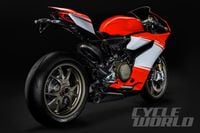
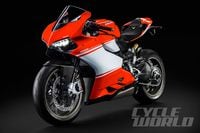
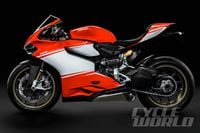
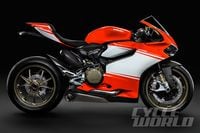
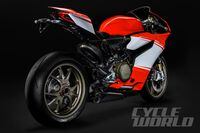
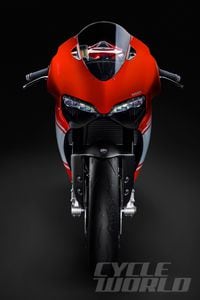
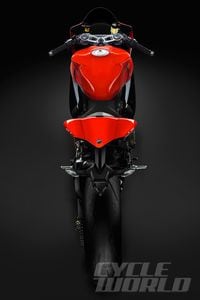
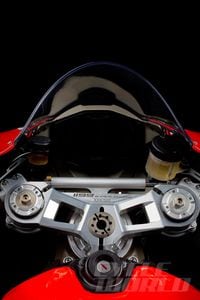
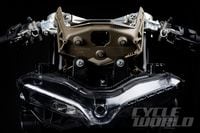
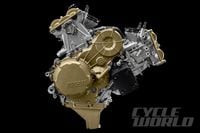
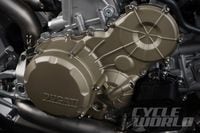
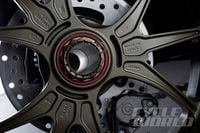
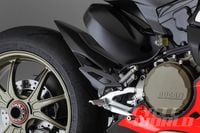

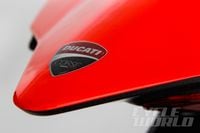
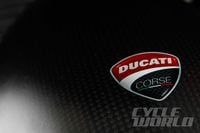
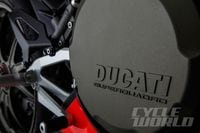
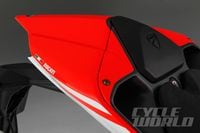
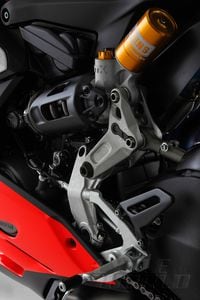
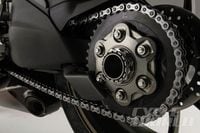
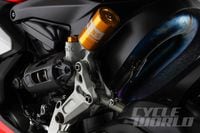
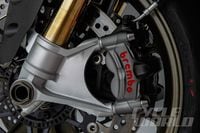
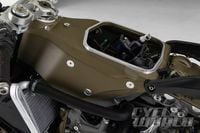
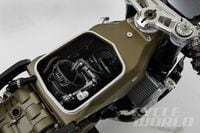
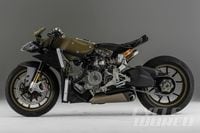
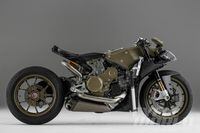
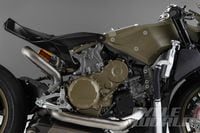
/cloudfront-us-east-1.images.arcpublishing.com/octane/5BDFMBN2KJE7JNJK7LJ7EG4A2M.jpg)
/cloudfront-us-east-1.images.arcpublishing.com/octane/C3WGBZCFABC7XKBCFCCXDWYWME.jpg)
/cloudfront-us-east-1.images.arcpublishing.com/octane/PLQ5M7MG3RG7BHYH2OILWJZIPY.jpg)
/cloudfront-us-east-1.images.arcpublishing.com/octane/CCPZFYVVRBF2DLPMDYKPF4TMME.jpg)
/cloudfront-us-east-1.images.arcpublishing.com/octane/SIAXQ2ZOPNBYBLPKJPCHIYGG6A.jpg)
/cloudfront-us-east-1.images.arcpublishing.com/octane/LRRTQXMMAFBVFOUYC2RI6ZBEAY.jpg)
/cloudfront-us-east-1.images.arcpublishing.com/octane/2NE3IENERFBTPDKVXPNTSMZZXE.jpg)
/cloudfront-us-east-1.images.arcpublishing.com/octane/7EG6FR6QOJGR7FFROLIPDUVTVM.jpg)
/cloudfront-us-east-1.images.arcpublishing.com/octane/QC73NNGYHZDWTNVTLNABEDJJ2Y.jpg)
/cloudfront-us-east-1.images.arcpublishing.com/octane/LMMTOYLL7BGE3FLR3OXDA4YQUI.jpg)
/cloudfront-us-east-1.images.arcpublishing.com/octane/EGXXXTWM2NABTOFTZBMZ2MWLUQ.jpg)
/cloudfront-us-east-1.images.arcpublishing.com/octane/EKKSANJIXNHQTNCANRHSTW7JHE.jpg)
/cloudfront-us-east-1.images.arcpublishing.com/octane/QSA4M5BQLFBAHIX33LEC63FH6M.jpg)
/cloudfront-us-east-1.images.arcpublishing.com/octane/OK3LWSOK3ZCMHJZZCEHOL2SRKQ.jpg)
/cloudfront-us-east-1.images.arcpublishing.com/octane/4E4BRX2RXVGNPCK4ODPMSUVBC4.jpg)
/cloudfront-us-east-1.images.arcpublishing.com/octane/SSLY6CGFJNDLVKSP5LBWZKVIHU.jpg)
/cloudfront-us-east-1.images.arcpublishing.com/octane/ENCTP2GIJ5DFVH2QPFJRFJ3IDI.jpg)
/cloudfront-us-east-1.images.arcpublishing.com/octane/P67HV34OANAFBDVK6U4FQ2M3YM.jpg)
/cloudfront-us-east-1.images.arcpublishing.com/octane/TG75U5MBR5FI3INUFFJEFMCOZI.jpg)
/cloudfront-us-east-1.images.arcpublishing.com/octane/T57XZZK3NVEHDPALKA6BHQ6HSI.jpg)
/cloudfront-us-east-1.images.arcpublishing.com/octane/AHKROF6VQFHGTDJUON7HYST3SE.jpg)
/cloudfront-us-east-1.images.arcpublishing.com/octane/WT6GUJIIQ5AFJPUZFOKJQUCM7I.jpg)
/cloudfront-us-east-1.images.arcpublishing.com/octane/2W2YYLKRUJHW5CQOQSZPOVNHI4.jpg)
/cloudfront-us-east-1.images.arcpublishing.com/octane/WOG6MLRJJRGFXHGMEZ5CT6OBKA.jpg)